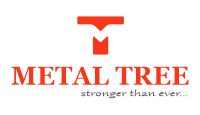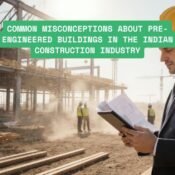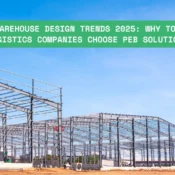
Pre-Engineered Buildings vs. Traditional Construction: Which is Better?
Introduction: A Real-World Business Dilemma
A few years ago, a mid-sized manufacturing business faced a crucial decision. The company, experiencing rapid growth, desperately needed a new facility. Like many business owners, the management team debated between traditional brick-and-mortar construction and newer, more innovative solutions. Faced with increasing material costs, prolonged project timelines, and operational disruptions, they found themselves in a bind.
The pressure mounted as each day delayed their expansion, causing losses and impacting the company's growth trajectory. This scenario isn't unique—countless businesses encounter this crossroads, questioning whether traditional construction methods still hold up in today's fast-paced world or if it's time to shift towards modern, efficient solutions like Pre-Engineered Buildings (PEBs).
This article explores both options, shedding light on their differences, pros, and cons, helping you make an informed decision for your business.
What Are Pre-Engineered Buildings?
Pre-Engineered Buildings, often referred to as PEBs, have revolutionized the construction industry. Essentially, a PEB is a building system designed and manufactured in a factory setting and then assembled on-site. The concept is simple—everything from the structural components to the exterior cladding is pre-designed based on precise measurements and requirements.
This method allows for the creation of various structures, including warehouses, factories, commercial complexes, and sports arenas. By optimizing the design, PEBs minimize the use of materials while maximizing strength and durability. One of the most significant benefits? Speed. Compared to traditional construction methods, which can take months or even years, PEBs can be completed in weeks, drastically reducing project timelines and costs.
What is Traditional Construction?
Traditional construction is the method most of us are familiar with. It involves building a structure brick by brick (or steel beam by steel beam) on-site, with all materials and labor handled at the project location. This conventional approach has been the go-to for centuries due to its flexibility in design and adaptability to unique site conditions.
Traditional construction allows architects and engineers to create custom designs, whether for residential houses or large commercial complexes. However, it often requires more time due to weather constraints, material sourcing issues, and on-site labor challenges.
"At Metal Tree, we believe that building strong foundations goes beyond structures—it's about creating reliable solutions that stand the test of time. Your vision, our expertise, one resilient future."
Key Differences: PEBs vs. Traditional Construction
When comparing Pre-Engineered Buildings and traditional construction, it's essential to understand their core differences:
- Design and Flexibility:
- PEBs are designed and manufactured based on pre-set templates but can be customized to a great extent. The main structural elements, such as columns and beams, are standardized, enabling faster fabrication and assembly.
- Traditional construction offers complete flexibility. If a business requires unique architectural designs or site-specific adjustments, traditional construction might be the better choice.
- Time Efficiency:
- PEBs are highly time-efficient. The components are fabricated in factories, minimizing on-site activities. This approach not only reduces construction time but also mitigates delays caused by weather or labor shortages.
- Traditional construction often faces delays due to external factors like weather conditions or labor disputes. Additionally, material procurement and manual assembly on-site can be time-consuming.
- Cost Considerations:
- PEBs offer cost savings through reduced material wastage and labor expenses. Businesses opting for PEBs benefit from lower overall construction costs and shorter timelines, directly translating to financial savings.
- Traditional construction costs can vary widely based on material prices, labor rates, and unforeseen circumstances during the project. It’s not uncommon for traditional projects to exceed budget estimates due to delays or unexpected complications.
- Sustainability and Environmental Impact:
- PEBs are designed with efficiency in mind. The controlled manufacturing environment results in minimal material wastage, making PEBs an eco-friendly option.
- Traditional construction often leads to higher material waste and environmental impact. However, eco-friendly materials and practices are becoming more common in conventional methods to mitigate this issue.
Advantages of Pre-Engineered Buildings
- Faster Construction: PEBs are pre-fabricated and only need to be assembled on-site, allowing projects to be completed up to 50% faster than traditional methods.
- Cost-Effectiveness: Reduced construction time, efficient use of materials, and minimal on-site labor directly lead to lower costs. For businesses looking to scale quickly, this can be a game-changer.
- Versatility and Scalability: PEBs can be adapted to various applications, from warehouses to multi-story buildings. They are easily scalable, allowing for expansions without major structural changes.
- Durability and Strength: The design of PEBs ensures structural integrity, often making them more resilient to harsh weather conditions compared to conventional buildings.
These benefits have made PEBs the go-to choice for businesses looking for efficiency, speed, and sustainability.
Advantages of Traditional Construction
- Custom Design Flexibility: Traditional construction allows for intricate designs and highly customized structures that may not be possible with standard PEB templates.
- Adaptability to Complex Sites: When working on difficult terrain or irregular plot shapes, traditional methods offer greater adaptability to adjust the structure based on site conditions.
- Tried and Tested Methods: For projects that require specific historical or cultural architectural elements, traditional construction remains the preferred choice.
Traditional construction remains relevant in scenarios where customization and architectural complexity are key priorities.
Conclusion: Which is Better?
Choosing between Pre-Engineered Buildings and traditional construction ultimately depends on your project requirements, budget constraints, and timelines. For many businesses in India and worldwide, the efficiency, cost savings, and sustainability of PEBs make them the preferred choice. However, for projects that demand high levels of customization and intricate design, traditional construction still holds significant value.
At Metal Tree, we understand the importance of making the right decision for your construction projects. With years of experience in delivering robust and innovative Pre-Engineered Buildings, we’re committed to helping businesses scale and grow efficiently. The key is to assess your specific needs and consult with experts who can guide you toward the best solution.
So, which will it be—modern efficiency with Pre-Engineered Buildings or the time-tested reliability of traditional construction?
2 thoughts on “Pre-Engineered Buildings vs. Traditional Construction: Which is Better?”
Add a Comment Cancel reply
All Categories
Recent Posts
How Much Does a Pre-Engineered Building Cost in India? Ultimate Price Guide
Tags
Call Us at
+91 9311624628





[…] factory-fabricated steel structures that are assembled on-site. They stand in contrast to traditional construction methods, where every part is built from scratch on-site. In PEBs, every component—from beams to […]
[…] was an obvious solution: to expand. Unfortunately, traditional construction came with expensive, lengthy timelines, and rigid layout options. The company needed faster, […]